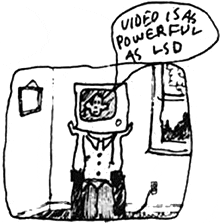We first encountered the work of Media Historian Peter Sachs Collopy during research for a previous blog article about video synthesizers.
His work was so interesting we invited Peter to do a short interview for the blog. Thanks Peter for taking time to respond, you can read the answers below!
We were really struck by your description of early video as a technology of consciousness. Can you tell us a bit more about this idea? Did early users of portable video technology use video in order to witness events?
Absolutely! Technology of consciousness is a term I found in communications scholar Fred Turner’s work, particularly his essay on the composer Paul DeMarinis (“The Pygmy Gamelan as Technology of Consciousness,” in Paul DeMarinis: Buried in Noise, ed. Ingrid Beirer, Sabine Himmelsbach, and Carsten Seiffarth [Heidelberg: Kehrer Verlag, 2010], 23–27). Every technology affects how we think and experience the world, but I use this phrase specifically to refer to technologies whose users understood that they were doing so. The quintessential examples are psychedelic drugs, which people use specifically in order to alter their consciousness. For many videographers in the 1960s and 1970, video was like a drug in that it helped a person see the world in new ways; a cartoon in the magazine Radical Software proclaimed, for example, that “Video is as powerful as LSD” (Edwin Varney, Radical Software 1, no. 3 [Spring 1971]: 6). Part of all of this was that following Aldous Huxley, people believed that psychedelics made it possible to break down the barriers of the individual and share consciousness, and following media theorist Marshall McLuhan and theologian/paleontologist Pierre Teilhard de Chardin, they believed that new electronic media had the same effects. In my research, I trace these ways of thinking about technologies of consciousness back to the influence of philosopher Henri Bergson at the turn of the century. So yes, people were using video to witness events, but just as importantly they were using video to witness—and to reinterpret, and even to constitute—themselves and their communities.

It’s striking how little discussion of aesthetics and the visual there was in venues like Radical Software, though of course art critics started writing about video in these terms in the late 1960s. People were often more interested in what differentiated the process of shooting video from film and other media, in its ability to be played back immediately or in its continuity as an electronic technology with the powerful media of television and computing. Sony’s first half-inch videotape recorders, using the CV format, had only half the vertical resolution of conventional television. CV decks could still be hooked up to ordinary television sets for playback, though, so they still became a way for users to make their own TV.
What’s your favourite piece of video equipment you have encountered in your research and why?
I have several Sony AV-3400 portapaks that I’ve bought on eBay, none of them quite in working order. Those were the standard tool for people experimenting with video in the early 1970s, so I’ve learned a lot from the tactile experience of using them. I also have a Sony CMA-4 camera adaptor which provides video out from an AVC-3400 portapak camera without using a deck at all; I’ve used that, along with digital equipment, to make my own brief video about some of my research, “The Revolution Will Be Videotaped: Making a Technology of Consciousness in the Long 1960s (see below).”
In your research you discuss how there has been a continuity of hybrid analogue/ digital systems in video art since the 1970s. Given that so much of contemporary society is organised via digital infrastructures, do you think analogue technologies will be reclaimed more widely as a tool for variability in the future, i.e., that there will be a backlash against what can be perceived as the calculating properties of the digital?
I’m not sure a reclaiming of analog technologies will ever take the form of an explicit social movement, but I think this process is already happening in more subtle ways. It’s most apparent in music, where vinyl records and analog synthesizers have both become markers of authenticity and a kind of retro cool. In the process, though, analog has shifted from a description of machines that worked by analogy—usually between a natural phenomenon such as luminance and an electrical voltage—to an umbrella term for everything that isn’t digital. In the context of moving images, this means that film has become an analog technology as the definition of analog has shifted—even though analog and digital video are still more technically similar, and have at times been more culturally related, than film and analog video. So yes, I think there’s a backlash against precision, particularly among some artistic communities, but I think it’s embedded in a more complex reclassification of technologies into these now dominant categories of analog and digital.

